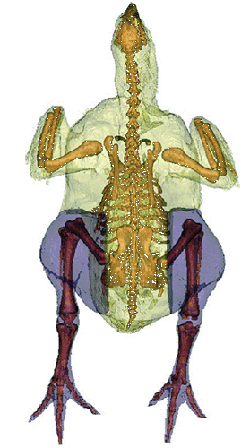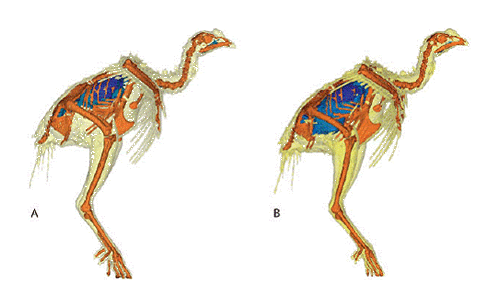



Biomechanical Compromises and Constraints on Locomotion and Breathing in Broiler Chickens
Each year, more than 30 billion broiler chickens are bred for human consumption; 800 million in the UK. Of these animals, up to 30 per cent develop some form of obvious lameness as well as heart and lung problems, costing perhaps £20 million per year in the UK alone, according to the Royal Veterinary College, London.
These problems are linked to selective breeding for rapid growth rates – broilers take only six weeks to reach a slaughter mass of almost 3kg, which has changed from 15 weeks to reach a smaller mass in the 1950s. As a result, the skeletons and other systems of broilers are immature, with potentially compromised abilities to adapt to their environment as they grow to large sizes. Activity levels decline steeply as broilers age. Welfare problems related to inactivity increase with age and there is controversial but building evidence that slaughter-age broilers are in pain. However global food security depends on economical and environmentally-friendly chicken meat; there may be no simple answers to this conundrum.

Dr John Hutchinson, with colleagues Dr Monica Daley, Heather Paxton (finishing a PhD with Dr. Hutchinson and moving on to a postdoc with him next), Dr Jonathan Codd and Dr Peter Tickle (University of Manchester) and colleagues, supported by major chicken breeder Cobb-Vantress, Inc., are beginning a new BBSRC-funded grant. They aim to develop a new scientific framework for understanding how the bodies of broilers change as they grow, focusing on the functions of the legs and their muscles during standing and walking, and the functions of the chest muscles during breathing when standing, sitting and walking. This framework would be founded on an extremely rigorous three-dimensional analysis (using x-rays) of how the skeleton actually is moved by the muscles during locomotion and breathing. It combines cutting-edge techniques for the experimental analysis of gait (including stability) and breathing (including metabolic energy cost for different activities) with anatomically-realistic 3D computer simulations of how the musculoskeletal system produces observed motions.
Dr Hutchinson says: "We have laid an excellent foundation with our past four years of research on similar topics in avian biology. Now we really want to make a positive impact for the birds and for people, maximally informed by scientific evidence. The technology is now at a point where some really cool science is possible, to get at some very basic questions about what has gone wrong with broiler chickens and how to make that more right. We’re going to capitalize on that, and I think everyone will benefit."
The team of researchers expects that their novel synthesis of these approaches will allow them to tease apart how the body shape and posture of broilers changes as they grow and how these changes influence standing, moving and breathing. This work should reveal tradeoffs between growth, health and behaviour, by filling a major gap in our understanding of broiler biology. Studies are yet to peer inside living broilers to see how their components work to achieve observed behaviours and how the interactions of these components influence the lives of broilers. Instead, most research has focused on external, qualitative observations of ‘lameness’ and ‘leg weakness’ during life or post-mortem diagnoses of numerous specific disorders. Their study aims to redress this imbalance by spanning the gap between functioning organs, organisms and populations of broilers.
Hutchinson et al. suspect that, as other studies hint, at two weeks of age broilers are quite adept at locomotion and breathing but these abilities tend to decline at four weeks and approach limits of viable performance at six weeks old. These declines could be driven by the rapid growth of edible breast muscles that make the body ‘front heavy’, destabilising the animal and making its legs work harder to support it, and concurrently make breathing more difficult. This could lead to fatigue, inactivity and poor health that might have parallels with the human obesity crisis, but again there is no simple solution to it.

Images on this page are from Allen et al. in The Anatomical Record 292:1442–1461 (2009).








